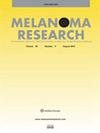Impact of gene expression profiling on diagnosis and survival after metastasis in patients with uveal melanoma.
IF 1.5
4区 医学
Q3 DERMATOLOGY
引用次数: 0
Abstract
Surveillance frequency for metastasis is guided by gene expression profiling (GEP). This study evaluated the effect of GEP on time to diagnosis of metastasis, subsequent treatment and survival. A retrospective study was conducted of 110 uveal melanoma patients with GEP (DecisionDx-UM, Castle Biosciences, Friendswood, Texas, USA) and 110 American Joint Committee on Cancer-matched controls. Surveillance testing and treatment for metastasis were compared between the two groups and by GEP class. Rates of metastasis, overall survival and melanoma-related mortality were calculated using Kaplan-Meier estimates. Baseline characteristics and follow-up time were balanced in the two groups. Patients' GEP classification was 1A in 41%, 1B in 25.5% and 2 in 33.6%. Metastasis was diagnosed in 26.4% (n = 29) in the GEP group and 23.6% (n = 26) in the no GEP group (P = 0.75). Median time to metastasis was 30.5 and 22.3 months in the GEP and no GEP groups, respectively (P = 0.44). Median months to metastasis were 34.7, 75.8 and 26.1 in class 1A, 1B and 2 patients, respectively (P = 0.28). Disease-specific 5-year survival rates were 89.4% [95% confidence interval (CI): 81.0-94.2%] and 84.1% (95% CI: 74.9-90.1%) in the GEP and no GEP groups respectively (P = 0.49). Median time to death from metastasis was 10.1 months in the GEP group and 8.5 months in the no GEP group (P = 0.40). There were no significant differences in time to metastasis diagnosis and survival outcomes in patients with and without GEP. To realize the full benefit of GEP, more sensitive techniques for detection of metastasis and adjuvant therapies are required.基因表达谱分析对葡萄膜黑色素瘤患者转移后的诊断和存活率的影响。
基因表达谱(GEP)可指导转移瘤的监测频率。本研究评估了基因表达谱对转移瘤诊断时间、后续治疗和存活率的影响。研究人员对 110 名采用 GEP(DecisionDx-UM,Castle Biosciences,Friendswood,Texas,USA)的葡萄膜黑色素瘤患者和 110 名与美国癌症联合委员会匹配的对照组患者进行了回顾性研究。对两组患者的监测检测和转移治疗进行了比较,并按 GEP 分级进行了比较。转移率、总生存率和黑色素瘤相关死亡率采用卡普兰-梅耶估计法进行计算。两组患者的基线特征和随访时间均衡。41%患者的GEP分级为1A,25.5%为1B,33.6%为2。GEP组中有26.4%(n = 29)的患者确诊为转移,无GEP组中有23.6%(n = 26)的患者确诊为转移(P = 0.75)。GEP 组和无 GEP 组的中位转移时间分别为 30.5 个月和 22.3 个月(P = 0.44)。1A、1B和2级患者的中位转移月数分别为34.7、75.8和26.1个月(P = 0.28)。GEP组和无GEP组的疾病特异性5年生存率分别为89.4%[95%置信区间(CI):81.0-94.2%]和84.1%(95% CI:74.9-90.1%)(P = 0.49)。GEP组患者死于转移瘤的中位时间为10.1个月,无GEP组为8.5个月(P = 0.40)。有 GEP 和没有 GEP 的患者在转移瘤确诊时间和生存结果方面没有明显差异。要充分发挥GEP的疗效,还需要更灵敏的转移灶检测技术和辅助疗法。
本文章由计算机程序翻译,如有差异,请以英文原文为准。
求助全文
约1分钟内获得全文
求助全文
来源期刊

Melanoma Research
医学-皮肤病学
CiteScore
3.40
自引率
4.50%
发文量
139
审稿时长
6-12 weeks
期刊介绍:
Melanoma Research is a well established international forum for the dissemination of new findings relating to melanoma. The aim of the Journal is to promote the level of informational exchange between those engaged in the field. Melanoma Research aims to encourage an informed and balanced view of experimental and clinical research and extend and stimulate communication and exchange of knowledge between investigators with differing areas of expertise. This will foster the development of translational research. The reporting of new clinical results and the effect and toxicity of new therapeutic agents and immunotherapy will be given emphasis by rapid publication of Short Communications. Thus, Melanoma Research seeks to present a coherent and up-to-date account of all aspects of investigations pertinent to melanoma. Consequently the scope of the Journal is broad, embracing the entire range of studies from fundamental and applied research in such subject areas as genetics, molecular biology, biochemistry, cell biology, photobiology, pathology, immunology, and advances in clinical oncology influencing the prevention, diagnosis and treatment of melanoma.
 求助内容:
求助内容: 应助结果提醒方式:
应助结果提醒方式:


